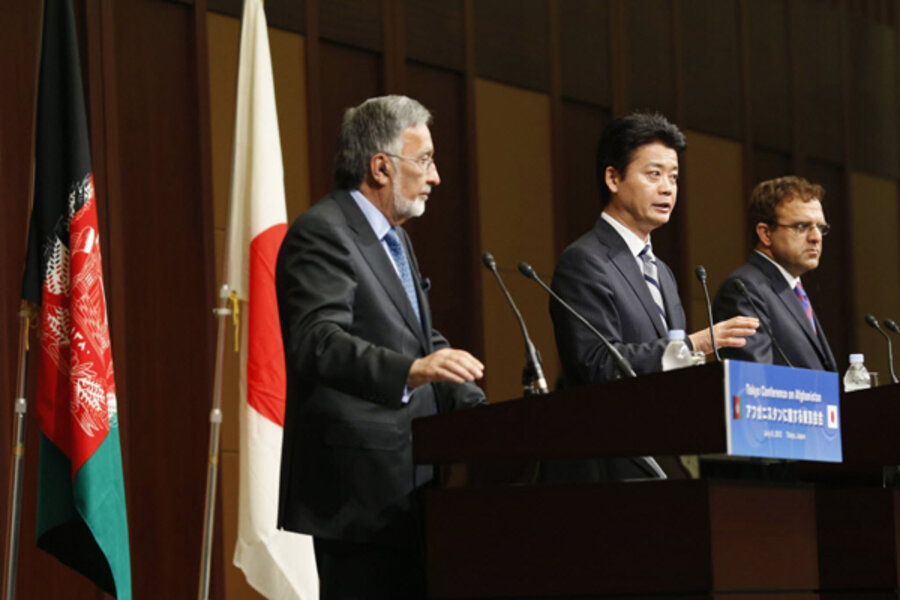Another $16 billion in aid, but Afghan businessmen say help us
Loading...
| Kandahar, Afghanistan
International donors representing about 70 countries and organizations met in Tokyo on Sunday to pledge $16 billion to Afghanistan’s reconstruction over the next four years.
The announcement was welcome news for many in Afghanistan, but nearly 11 years into the US-led war many Afghans and international officials have expressed considerable disappointment with an aid effort that they say has fallen short thus far. With these new pledges in place, there is hope that lessons learned will be applied to improve aid spending in the coming years.
Among complaints of fraud, mismanagement, waste, and missed opportunities that Afghans want addressed, many say they would like to see foreign assistance work harder to adequately develop Afghanistan’s private sector so it can begin to create jobs and a sustainable economy.
“The government does not have the capacity to create more jobs. The only way to create more employment opportunities is to support the private sector,” says Mohammad Rahim Rahimi, director of the Ministry of Economics in Kandahar. “We are still asking the international community for support, but if they had spent development money appropriately I’m sure we would be self-sufficient and we would be able to support our economy.”
Despite the improvements foreign aid has brought to Afghanistan, it’s also managed to place the economy in a perilous position where it is dependent on aid for its existence. Presently 90 percent of the Afghan government’s budget depends on foreign aid and money from the international donor community and military spending makes up about 97 percent of the country’s GDP.
In this climate, a generation of young professionals has come of age only knowing employment in the lucrative non-governmental organization (NGO) sector and is now struggling to find work as donor spending decreases.
Since graduating from college in 2006, Abdul Ahad has worked only for NGOs. Now the program coordinator for Human Resources Development Agency, he says that his organization is down from a high of six donor-funded projects that employed a total of about 150 in 2009 to only two projects and a third minor one that employ just 25 people.
Speaking about colleagues who lost their jobs, Mr. Ahad says, “They are not getting jobs in the NGO sector, they are getting jobs in the private sector with small businesses and low salaries.” The NGO sector is known throughout Afghanistan for providing salaries well above market rates.
Meanwhile, those who’ve sought to create economic opportunities outside the world of international donor spending say they’ve received limited support.
In 2003, Khalilurahman Ahmadi and his brothers decided to start a pipe and plastic factory in Kandahar. Though the family business was fruit import and export with no factory experience, Mr. Ahmadi says he and his brothers felt inspired to “help the country,” which was in dire need of industry. Since then, Ahmadi has focused on building the family’s new company, Imran Atiqu PVC.
Initially, several family friends from Iran and Pakistan with experience in running a plastic factory came to Afghanistan to help, but they left when security began deteriorating in 2005 and 2006.
Ahmadi, who has only a sixth-grade education and no factory background, could not train employees and he says he found little help from the international community. What training they did provide in Kandahar he says was usually related to management skills, not technical education.
Ahmadi also must deal with employees who are often illiterate with no formal education to speak of. Such employees are prone to make mistakes using digital scales, a serious problem in the plastics business where a minor measurement error can seriously change the composition of a pipe.
“In the last 11 years we have change from the money that has been spent. We have security forces, some roads were built, and some other projects were implemented. But as for support for the private sector, I am not happy,” says Ahmadi.
One of the most serious problems Ahmadi faces is the lack of a sustainable electricity source. The US has provided generator power that electrifies the industrial area that is home to Imran Atiqu PVC and other factories, but Americans still provide the fuel to power the generators. Despite commitments at the Tokyo conference, there are still concerns about what will happen as US and NATO forces draw down.
Only 18 percent of Afghanistan has access to reliable electricity, up from 6 percent in 2002. In Kandahar, the second largest city in Afghanistan, there is much frustration that hydroelectric dam projects in the area that could solve this problem remain incomplete.
“Billions of dollars have been spent in Afghanistan, but what have we gotten as a benefit?” says Mohammad Kabir Darwaish, an independent economic analyst in Kandahar. “We spent all this money, but the main thing that can support our economy is electricity and it has not been built.”
More than industry, throughout Afghanistan many are betting on the mining sector and finding new markets for agricultural products to fill in the gaps as donor spending inevitably recedes. The mining sector, however, has yet to become operational and begin creating jobs or revenue for the state.
The latest round of international pledges of assistance comes with more strings attached. The money is conditional on the Afghan government reducing corruption and improving governance. In addition to taking stronger anti-corruption measures, the Afghan government must meet good governance standards to receive up to 20 percent of the donor money.





